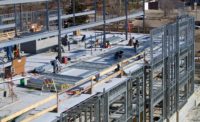With the rapid creation and development of new materials, made possible by advancements in material science, questions have arisen regarding whether specific substances used to deliver improved fire protection need to be balanced against any potential impact to the environment or society’s increased focus on personal health effects. As early as the mid-2000s, governments worldwide simultaneously commenced a systematic review of numerous chemicals to determine what threat, if any, they may pose either to the natural environment or to human health. This is an important debate that encompasses a broad range of issues and merits close scrutiny to carefully weigh the consequences of such a complex risk/benefit analysis.
In one such case, hexabromocyclododecane (HBCD), the flame retardant used in polystyrene rigid foam insulation, has undergone a formal chemical review process to identify potential risks associated with its production and use in a variety of applications, including foam insulation, computer housing components and in textiles.
Opponents of HBCD argue that it is a harmful toxin and its alleged health risks outweigh the fire protection benefit it provides. However, this assumption is based upon a flawed interpretation of both the way HBCD interacts with human biology and how it contributes to improved fire safety. HBCD has been classified as a persistent, bioaccumulative toxin. While it is true that HBCD has been proven to be bioaccumulative, its persistence is borderline and there is no evidence to show that it is a threat to human health. The PBT classification does not require that a chemical meet all three criteria. Risk assessment studies conducted by Environment Canada and the European Chemical Agency have concluded that HBCD poses no health risk to consumers or the general public because exposure levels are too low to pose any danger.
ROLE OF FLAME RETARDANTS
Flame retardants play a crucial role in reducing the devastating impact of fires on people, property and the environment. Contrary to popular belief, a flame retardant does not make a material fireproof. Instead, they are intended to prevent fires from igniting or slow the spread of a fire, providing precious extra time for building residents to get to safety, and for firefighters to contain the blaze. According to the Materials Flammability Group of the National Institute of Standards and Technology, products treated with FRs significantly slow fire spread when compared to untreated products. This makes FRs a crucial component for buildings with foam insulation to meet standards set by fire codes.
Current fire performance test requirements in building codes were established through a robust public development process that drew on the expertise and analysis by fire scientists, fire services, fire testing laboratories, construction industry experts and building code officials. Between 1977 and 2011, civilian fire deaths declined from 7,395 to 3,005. Despite this, a code change has recently been introduced that would sidestep ASTM testing requirements, which includes flame spread and smoke developed measurements, for foam insulation behind a thermal barrier or on external below grade foundation walls. This would allow foam insulation not treated with FRs to be used in residential construction, removing an important layer of fire safety. While the change does require additional thermal barriers as an added defense in the absence of FRs, there is no scientific data to support this recommendation. Without adequate testing to prove this alternative method likewise meets fire code, this recommendation is without merit.
Until recently, HBCD has been the only approved flame retardant that is compatible with the styrene polymerization process. Despite little to no evidence to support its removal, the wheels are already in motion to remove HBCD from the market. Even so, the foam insulation industry is voluntarily taking proactive measures to introduce a replacement flame retardant before any regulatory mandates or deadlines come in to effect. A transition to substitute HBCD with the new flame retardant is already in progress.
THE NEW FLAME RETARDANT
Similar to HBCD, the new FR is a brominated compound, which means that it retains the same fire resistant qualities but is a much larger molecule. As a result, it is not bioaccumulative in either humans or the environment. The new flame retardant is persistent which allows it to provide long lasting fire protection in polystyrene building insulation. Produced in a pelletized form, the new FR is much easier to handle than HBCD, which is made as a powder, and minimizes emissions in the manufacturing process. It also has less of a tendency to retain water, which is an important factor for foam insulation.
Chemical manufacturers that currently produce HBCD are in the process of scaling up the production of the new FR, intending to help insulation manufactures make a seamless and cost-effective transition. Outlook for the HBCD replacement is very positive, representing the industries ongoing commitment to continuous improvement. The new FR replacement is already smoothly underway in Japan.
The foam insulation industry recognizes the need to take action in response to any concerns with its product performance and use. Product safety—on all fronts—is of paramount importance. Along with superior energy efficiency, polystyrene foam insulation meets a unique market need and is constantly undergoing refinements in response to any concerns that may come into question.











